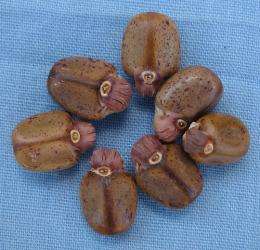Study identifies human melanoma stem cells

(Medical Xpress)—Cancer stem cells are defined by three abilities: differentiation, self-renewal and their ability to seed a tumor. These stem cells resist chemotherapy and many researchers posit their role in relapse. A University of Colorado Cancer Center study recently published in the journal Stem Cells, shows that melanoma cells with these abilities are marked by the enzyme ALDH, and imagines new therapies to target high-ALDH cells, potentially weeding the body of these most dangerous cancer creators.
"We've seen ALDH as a stem cell marker in other cancer types, but not in melanoma, and until now its function has been largely unknown," says the paper's senior author, Mayumi Fujita, MD, PhD, investigator at the CU Cancer Center and associate professor in the Department of Dermatology at the CU School of Medicine.
Fujita's group transplanted ALDH+ and ALDH- melanoma cells into animal models, showing the ALDH+ cells were much more powerfully tumorigenic. In the same ALDH+ cells, the group then silenced the gene that creates this protein, finding that with ALDH knocked down, melanoma cells died in cultures and lost their ability to form tumors in animal models. In cell cultures, silencing this ALDH gene also sensitized melanoma cells to existing chemotherapies. When the group explored human tumor samples, they found distinct subpopulations of these ALDH+ cells, which made up about 0.1-0.2 percent of patients' primary tumors. In samples of metastatic melanoma – the most aggressive form of the disease – the percentage of ALDH+ cells was greater, even over 10 percent in some tumors, further implying the powerful danger of these cells.
"In these same ALDH+ cells, we find the markers of stem cells are upregulated and those of cell differentiation are downregulated. In addition to these clues, ALDH+ cells generate the heterogeneous cell types seen in the original tumor," says Fujita, meaning that in addition to self-renewal and tumorigenesis, ALDH+ cells fulfill the third criteria for a cancer stem cell: the ability to differentiate.
The study also shows how the ALDH gene and its protein act to create a cell's stem-like properties.
"One way ALDH makes a cancer stem cell is through the retinoic acid signaling pathway," Fujita says. The protein ALDH leads to the overproduction of retinoic acid, which in turn binds to a cell's nuclear receptors and influences the expression of many of the cell's genes – for example, genes involved in regulating cell survival, repair, and proliferation, all of which combine to confer chemoresistance. Target cells with high ALDH and you target all the downstream effects, including the retinoic acid signaling pathway.
"Our hope is that we can intervene in this signaling, either at the level of ALDH or elsewhere in the pathway, especially to re-sensitize cells to chemotherapy. Using a new drug to take away a melanoma stem cell's chemoresistance could boost the effectiveness of existing drugs," Fujita says.
More information: Stem Cells DOI: 10.1002/stem.1193
















